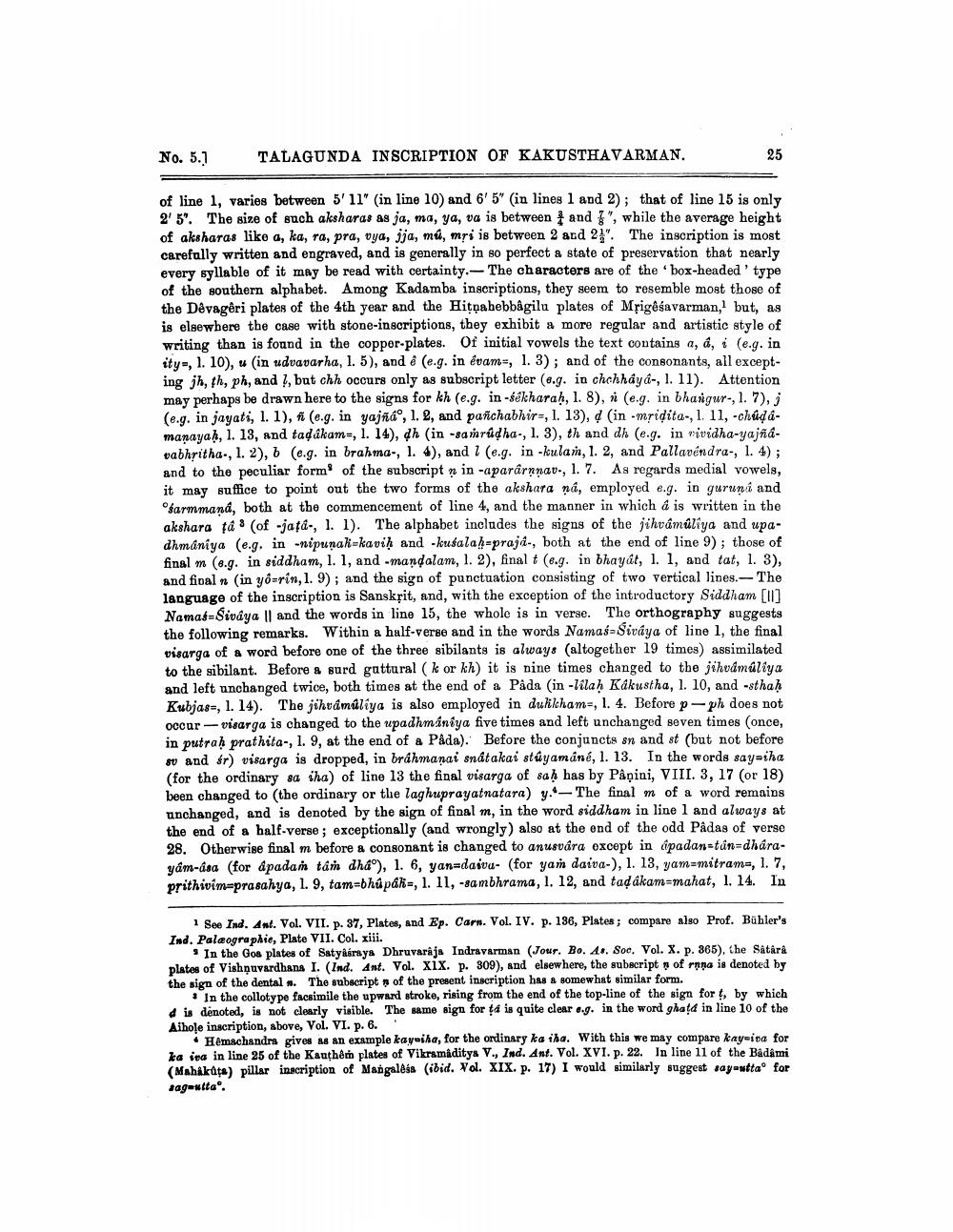________________
No. 5.1
TALAGUNDA INSCRIPTION OF KAKUSTHAVARMAN.
of line 1, varies between 5' 11" (in line 10) and 6'5" (in lines 1 and 2); that of line 15 is only 2' 5'. The size of such aksharas as ja, ma, ya, va is between 1 and 3", while the average height of aksharas like a, ka, ra, pra, uya, jja, mú, mi is between 2 and 2". The inscription is most carefully written and engraved, and is generally in so perfect a state of preservation that nearly every syllable of it may be read with certainty. The characters are of the "box-headed' type of the southern alphabet. Among Kadamba inscriptions, they seem to resemble most those of the Dévagêri plates of the 4th year and the Hitpahebbâgilu plates of Mrig@savarman, but, as is elsewhere the case with stone-inscriptions, they exhibit a more regular and artistic style of writing than is found in the copper-plates. Of initial vowels the text contains a, a, i (e.g. in itys, 1. 10), (in udvavarha, 1. 5), and & (e.g. in évams, 1.3); and of the consonants, all excepting jh, th, ph, and ?, but chh occurs only as subscript letter (6.g. in chchhaya-, 1. 11). Attention may perhaps be drawn here to the signs for kh (e.g. in -śékharah, 1. 8), n (e.g. in bhangur., 1. 7), (e.g. in jayati, 1.1), fi (e.g. in yajñá°, 1.2, and panchabhira, 1. 13), 4 (in -
midita-, 111, -chudámanayah, 1. 13, and tadůkams, 1. 14), dh (in -sanrúdha., 1. 3), th and dh (e.g. in vividha-yajña. vabhritha., 1. 2), b (e.g. in brahma-, 1.4), and I (e.g. in -kulam, 1.2, and Pallavendra., 1. 4); and to the peculiar form of the subscript n in-aparárnnav., 1. 7. As regards medial vowels, it may suffice to point out the two forms of the akshara nå, employed e.g. in guruni and
farmmand, both at the commencement of line 4, and the manner in which & is written in the akshara 8 % (of -jata., l. 1). The alphabet includes the signs of the jihrámiliya and upadhmaniya (e.g, in -nipunah-kaviḥ and -kućalahpraja-, both at the end of line 9); those of final m (e.g. in siddham, 1. 1, and mandalam, 1. 2), final t (6.g. in bhayát, l. 1, and tat, 1. 3), and final » (in yo=rin, 1. 9); and the sign of punctuation consisting of two vertical lines.-- The language of the inscription is Sanskřit, and, with the exception of the introductory Siddham [11] Namas-Sivaya ll and the words in line 15, the whole is in verge. The orthography suggests the following remarks. Within a half-verse and in the words Namas-Sivaya of line 1, the final visarga of a word before one of the three sibilants is always (altogether 19 times) assimilated to the sibilant. Before & surd guttural ( k or kh) it is nine times changed to the jihvámúliya and left unchanged twice, both times at the end of a Påda (in-lilah Kakustha, 1. 10, and -sthah Kubjas-, l. 14). The jihrámiliya is also employed in dukham, 1. 4. Before p-ph does not occur - visarga is changed to the upadhmíniya five times and left unchanged seven times (once, in putrah prathita-, 1. 9, at the end of a Pada). Before the conjuncts on and st (but not before su and fr) visarga is dropped, in brahmanai snátakai stúyamané, 1. 13. In the words say=iha (for the ordinary sa cha) of line 13 the final visarga of sah has by Påộini, VIII. 3, 17 (or 18) been changed to the ordinary or the laghuprayatnatara) y. The final m of a word remains anchanged, and is denoted by the sign of final m, in the word siddham in line 1 and always at the end of a half-verse; exceptionally (and wrongly) also at the end of the odd Pâdas of verse 28. Otherwise final m before a consonant is changed to anusvára except in ápadantandharayam-asa (for åpadan tâm dhao), 1. 6, yan-daiva- (for yam daiva-), 1. 13, yam-mitrams, 1. 7, prithivim-prasahya, 1. 9, tam=bháp&k=, 1. 11, -sambhrama, 1. 12, and tadakam=mahat, 1. 14. In
1 See Ind. Ant. Vol. VII. p. 37, Plates, and Ep. Carn. Vol. IV. p. 136, Plates; compare also Prof. Bühler's Ind. Paleographie, Plate VII. Col. xiii.
. In the Gos plates of Satykiraya Dhruvaraja Indravarman (Jour. Bo. 4. Soc. Vol. X. p. 865), the Satara plates of Vishnuvardhana I. (Ind. Ant. Vol. XIX. p. 309), and elsewhere, the subscript of runa is denoted by the sign of the dental. The subscript of the present inscription has a somewhat similar form.
In the collotype facsimile the upward stroke, rising from the end of the top-line of the sign for ļ, by which d is denoted, is not clearly visible. The same sign for ta is quite clear e.g. in the word ghata in line 10 of the Aihole inscription, above, Vol. VI. p. 6.
• Hémachandrs gives as an example kayoiha, for the ordinary ka iha. With this we may compare kay-ina for ka iva in line 25 of the Kanthêm plates of Vikramaditya V., Ind. Ant. Vol. XVI. p. 22. In line 11 of the Badâmi (Mahikata) pillar inscription of Mangalesa (ibid. Vol. XIX. p. 17) I would similarly suggest say-utta for sag-ulta.




